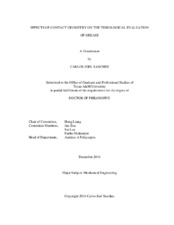| dc.description.abstract | This research investigates the influence of morphological characteristics on tribological performance of lubricating grease. The use of grease as a semi-solid lubricant has been well established in reducing friction and improving overall performance of moving parts in mechanical systems. Tribological evaluation has been tailored to specific applications individually such that the fundamental understanding has not be achieved as much as oils. This research aims to establish a more consistent methodology to evaluate any type of grease and obtain an understanding in the influence of morphological characteristics on tribological performance. New experimental approaches were used to support this research. This includes grease formulation, and tribotesting using various methodologies to evaluate the performance of grease. Unique testing apparatuses and procedures were developed to reveal insight into lubricating performance.
Tribotests were designed and evaluated against various contact configurations. Contacts of point, line, and area were comparatively studied. In this research, four grease formulations were investigated using three different contact geometries. The formulations included an industry standard compound, and a base petroleum grease. Analysis of tribotest results showed that the frictional performance follow a similar trend despite their contact configurations. Using a contact factor, those tests could be unified and compared directly. In addition, an in situ approach reveals that a shear stress could be effectively support dispersion of additives in grease. Gaining a better understanding of the lubricating behavior of grease will contribute to the development of more efficient grease formulations, and allow for more accurate recommendations for grease lubricating practices.
This research has significance for industries and applications where grease lubrication is critical; such as oil and gas, automotive, aerospace, and general bearing applications. Greases used in the oil and gas industry for example contain numerous additives. One primary concern is the homogenization of a grease mixture. Since grease consist of many individual components, they will have a tendency to separate and produce inconsistent. These grease compounds must be able to perform well under high contact pressures and at high temperatures for deep well drilling. Situations such as these pose many challenges in regards to the testing equipment used to evaluate them, as well as computational methods used to analyze the resultant data. | en |


